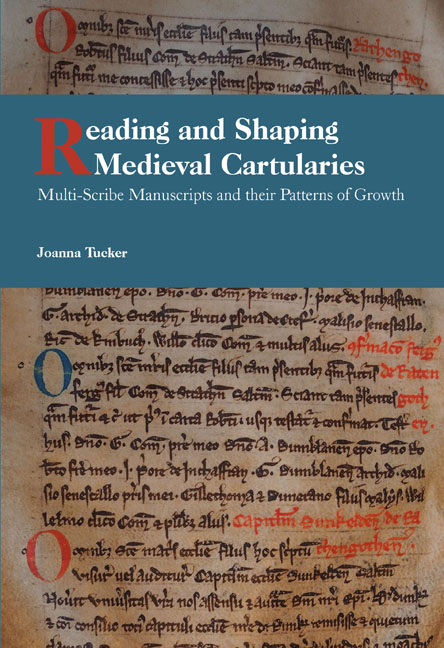Book contents
- Frontmatter
- Contents
- List of Plates
- List of Figures
- List of Tables
- Acknowledgements
- List of Abbreviations
- Conventions
- Introduction
- 1 Cartulary Studies
- 2 Analysing a Multi-Scribe Cartulary
- 3 The Creation and Growth of the Glasgow RV
- 4 The Creation and Growth of Lindores Caprington
- 5 Understanding the Patterns of Growth in Multi-Scribe Cartularies
- 6 Conclusion
- Appendix: Contents of the two Cartularies by ‘Series’
- Bibliography
- Index
- Studies in Celtic History
5 - Understanding the Patterns of Growth in Multi-Scribe Cartularies
Published online by Cambridge University Press: 13 April 2021
- Frontmatter
- Contents
- List of Plates
- List of Figures
- List of Tables
- Acknowledgements
- List of Abbreviations
- Conventions
- Introduction
- 1 Cartulary Studies
- 2 Analysing a Multi-Scribe Cartulary
- 3 The Creation and Growth of the Glasgow RV
- 4 The Creation and Growth of Lindores Caprington
- 5 Understanding the Patterns of Growth in Multi-Scribe Cartularies
- 6 Conclusion
- Appendix: Contents of the two Cartularies by ‘Series’
- Bibliography
- Index
- Studies in Celtic History
Summary
The point has now been reached where we can draw together the analysis of the two multi-scribe manuscripts in this study: the earliest cartularies of Glasgow Cathedral (the Glasgow RV) and Lindores Abbey (Lindores Caprington). Both were initially begun in the thirteenth century and continued to receive additions of text and folios across the thirteenth, fourteenth, and fifteenth centuries. Ascertaining the creation and growth of these two cartularies has been possible because of the methodology which provides a framework for integrating the manuscript's textual and ‘physical’ evidence. With a clear understanding of how each of these two cartularies grew, we can now begin to consider why they grew.
The first part of this chapter will consider the work of the initial scribes in both cartularies. It will then turn to the growth of the manuscripts, focusing on both their physical extension and the nature of the textual additions, particularly their scale, date, and order. One notable aspect of the textual content will then be discussed: the phenomenon of ‘repeated’ or ‘duplicated’ texts within each cartulary. This is a particularly vexed issue in cartulary studies; a fresh perspective can now be offered in the context of multi-scribe cartularies. The question of why the cartularies ‘grew’ in small stages will then be directly addressed. A new view will emerge, one in which the scribes were also readers and in which the cartularies were objects that were actively read and shaped by their community. Finally, this chapter will consider the institutional context of these two cartularies from Glasgow Cathedral and Lindores Abbey, including the communities’ reading cultures, how much authority was exercised over the manuscripts, and how the cartularies might have related to identity formation. While much of this remains unknown and unknowable, these are important questions to consider if we are to use the cartularies as a source for those communities that created and extended them.
The initial creation of the cartulary manuscripts
The initial scribes represent the earliest stage in a cartulary's lifetime. As such, they have received the most attention in studies of cartularies. Since they typically contributed the most material and also had to make decisions about how to arrange the texts, their work is naturally regarded as the most informative source for understanding a cartulary's function.
- Type
- Chapter
- Information
- Reading and Shaping Medieval CartulariesMultiple Scribes and Patterns of Growth, pp. 187 - 222Publisher: Boydell & BrewerPrint publication year: 2021

